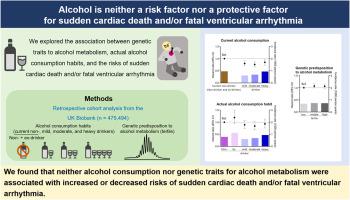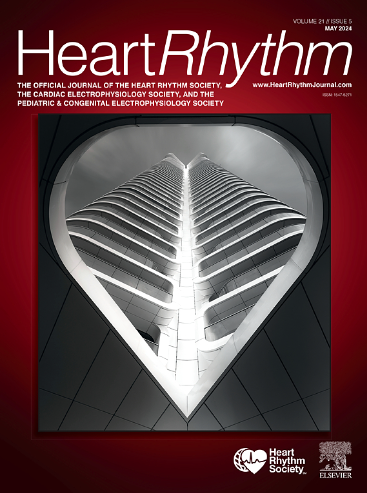Alcohol is neither a risk factor nor a protective factor for sudden cardiac death and/or fatal ventricular arrhythmia: A population-based study with genetic traits and alcohol consumption in the UK Biobank
IF 5.7
2区 医学
Q1 CARDIAC & CARDIOVASCULAR SYSTEMS
引用次数: 0
Abstract
Background
The association between alcohol consumption and the risk of sudden cardiac death and/or fatal ventricular arrhythmia remains controversial.
Objective
We analyzed the association between alcohol consumption, genetic traits for alcohol metabolism, and the risk of sudden cardiac death and/or fatal ventricular arrhythmia.
Methods
We identified 397,164 individuals enrolled between 2006 and 2010 from the UK Biobank database and followed them until 2021. Alcohol consumption was categorized as current nondrinkers (nondrinkers and ex-drinkers), mild drinkers, moderate drinkers, or heavy drinkers. Genetic traits of alcohol metabolism were stratified according to the polygenic risk score tertiles. The primary and secondary outcomes were a composite of sudden cardiac death and fatal ventricular arrhythmia as well as their individual components.
Results
During follow-up (median 12.5 years), 3543 cases (0.89%) of clinical outcomes occurred. Although mild, moderate, and heavy drinkers showed deceased risks of outcomes compared with current nondrinkers, there was no prognostic difference among nondrinkers, mild drinkers, moderate drinkers, and heavy drinkers. Ex-drinkers showed an increased risk in univariate analysis, but the significance was attenuated after adjusting covariates (hazard ratio 1.19; 95% confidence interval 0.94–1.50). As a continuous variable, alcohol consumption was not associated with clinical outcomes (hazard ratio 1.01; 95% confidence interval 0.99–1.02). Consistent with these findings, there was no association between genetic traits for alcohol metabolism and the risk of clinical outcomes.
Conclusion
Alcohol consumption was neither a protective factor nor a risk factor for sudden cardiac death or fatal ventricular arrhythmia. Genetic traits of alcohol metabolism were not associated with the clinical prognosis.


酒精既不是心脏性猝死和/或致命性室性心律失常的风险因素,也不是其保护因素;一项基于英国生物库中遗传特征和酒精消耗量的人群研究。
背景:饮酒与心脏性猝死和/或致命性室性心律失常风险之间的关系仍存在争议:我们分析了饮酒、酒精代谢遗传特征与心脏性猝死和/或致命性室性心律失常风险之间的关系:我们从英国生物库数据库中找到了 2006 年至 2010 年间登记的 397,164 名受试者,并对他们进行了跟踪调查,直至 2021 年。饮酒者分为目前不饮酒者(不饮酒者和曾饮酒者)、轻度饮酒者、中度饮酒者和重度饮酒者。酒精代谢的遗传特征根据多基因风险分级进行分层。主要和次要结果是心脏性猝死和致命性室性心律失常的综合结果,以及它们各自的组成部分:结果:在随访期间(中位数为 12.5 年),共出现了 3 543 例临床结果。虽然与不饮酒者相比,轻度、中度和重度饮酒者出现预后不良的风险较低,但不饮酒者、轻度饮酒者、中度饮酒者和重度饮酒者之间在预后方面没有差异。在单变量分析中,曾饮酒者的风险增加,但在调整协变量后,其显著性有所减弱(危险比(HR)1.19;95% 置信区间[CI]:0.94-1.50):0.94-1.50).作为一个连续变量,饮酒与临床结果无关(HR 1.01;95% CI 0.99-1.02)。与这些研究结果一致,酒精代谢的遗传特征与临床结果风险之间也没有关联:结论:饮酒既不是心脏性猝死或致命性室性心律失常的保护因素,也不是其风险因素。酒精代谢的遗传特征与临床预后无关。
本文章由计算机程序翻译,如有差异,请以英文原文为准。
求助全文
约1分钟内获得全文
求助全文
来源期刊

Heart rhythm
医学-心血管系统
CiteScore
10.50
自引率
5.50%
发文量
1465
审稿时长
24 days
期刊介绍:
HeartRhythm, the official Journal of the Heart Rhythm Society and the Cardiac Electrophysiology Society, is a unique journal for fundamental discovery and clinical applicability.
HeartRhythm integrates the entire cardiac electrophysiology (EP) community from basic and clinical academic researchers, private practitioners, engineers, allied professionals, industry, and trainees, all of whom are vital and interdependent members of our EP community.
The Heart Rhythm Society is the international leader in science, education, and advocacy for cardiac arrhythmia professionals and patients, and the primary information resource on heart rhythm disorders. Its mission is to improve the care of patients by promoting research, education, and optimal health care policies and standards.
 求助内容:
求助内容: 应助结果提醒方式:
应助结果提醒方式:


